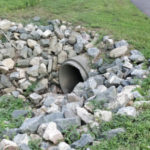 So, the saga continues. If you recall in our last journey update, we were working on access to our property. If you missed it, hop on over to the blog post about “Easements and Road Frontage” and check it out first. As we continue to work on access to our property, things never seem to be as easy as they ought to be. You would think that if you own your property it would be as simple as finding some dirt, rocks, and building yourself a driveway, but not so.
So, the saga continues. If you recall in our last journey update, we were working on access to our property. If you missed it, hop on over to the blog post about “Easements and Road Frontage” and check it out first. As we continue to work on access to our property, things never seem to be as easy as they ought to be. You would think that if you own your property it would be as simple as finding some dirt, rocks, and building yourself a driveway, but not so.
In the area where we want to put a driveway, the access would touch a state-maintained road. In the state of North Carolina, we have learned that anytime your driveway touches a state-maintained highway, the state must be the entity to build that initial portion of the access. In order to make this happen a few things must occur:
- You must contact your local/district NC Department of Transportation (NCDOT) office and…
- Obtain an application for a “Driveway Permit”
- Schedule someone from NCDOT to go out to your property to tell you what size culvert pipe you will need (more on this later)
- Once you have completed step 1b, then you can go out to the place where you want the driveway and mark it with flags (or something that will let NCDOT know that’s where you want the driveway to be).
- Order your culvert pipes and have them shipped to the location and placed near where you want them installed, and finally…
- Call your district NCDOT again to schedule them to come install the driveway. They’ll bring all the dirt, rocks, and equipment to do the job.

The cool part about this is that NCDOT will do all of the installation for free. From my understanding, the Driveway Permit is free as well. It is just a document that the workers will post up at the site while they are installing the driveway from the road to your property. Now, the rest of the driveway is your responsibility to complete as you wish, but at least that portion is done.
It sounds like a relatively straight forward process, but there are a few things you’ll have to navigate if you are doing this yourself. Remember, I said that you have to schedule NCDOT to tell you what size culvert you would need? Well if you haven’t noticed, most two-lane state-maintained highways have ditches that run along either side. This is to allow for water run-off from the road and to flow away. Because you cannot block these ditches you need to have a culvert pipe installed. In our case we need to have a 15-inch diameter culvert installed instead of the 12-inch because it is a pretty wide area from the road to the property. In addition, you need at least 20-feet of pipe. No problem. Well, not really.
See, if we were going the route of building right away, the builder would take care of the land access and driveway creation. But, since we are simply working on access and will be building later, we are taking this on ourselves (not to mention, this will save a little money on our part). The challenge is that for this particular project NCDOT recommends concrete culverts. For the sized pipes that we need, they are about 1,120-1,200lbs each for an 8-foot section. Our project is small in comparison to a commercial build. We need at least 20 feet of pipe, and will have to order 3 sections of it. Because we are ordering so few pieces of pipe, the company will not ship, which means we have to find someone to deliver them for us. The selling company will load them on a truck we provide from their site, but we’d still be stuck with unloading them once we got them on our site.
Moving over 1,000lbs of concrete without equipment is a slight problem. I talked to a co-worker and he suggested using a steel culvert pipe and I thought to myself, “Self, there is a steel culvert pipe company down the street from the office!!!”. I called up that company and they gave me the prices to which I was very satisfied. They are about 12lbs per linear foot too! This means for a 22-foot section of pipe it would only be 264lbs! I thought that was just awesome because we can handle that and steel is just as strong (if not stronger) than concrete depending on the application. The only caveat was that the steel pipe needed to have at least a foot of cover (ie, it needed to be buried at least a foot below the driveway) and stick out a foot on either side of the driveway. So, I called NCDOT and asked if I could use a steel culvert pipe and the answer was a negative. It was not that the use of the steel pipe was disallowed. The issue was that while the steel pipe met NCDOT’s standards for culverts, for our project, the pipe would not have been under a foot of cover. In fact, NCDOT’s standards were that they must be under 18-inches (or a 1 1/2 feet) of cover. With a 15-inch diameter pipe, it just would not have met their standards…and that sucks.
So, that put us back to square one. We know where to get the concrete culverts, but we just have to find someone to ship and unload them for us. Yep, the journey continues and like everything else, this too shall pass. Stay tuned as we continue to work on our driveway for property access!
NOTE: Our experiences are in the state of NC and this could be different in your state. I HIGHLY recommend to check with your local County Planning office as well as your district Department of Transportation before creating an access from a road to your property. There are utilities that could be in the ground or you could build your driveway only to have officials make you take it out because it is not up to code. So again, check with your local offices before starting a project like this!
If you hire a builder for your house, they will take care of getting permits, driveway completed, etc. When we built our house, I only needed to indicate where we wanted the driveway and how long it needed to be.
Vera you are right! But, we are working on things phases to which building may have to come a little later. Not to mention, we would like to do some work ourselves and save a little money. The downside to that is we have to orchestrate everything, but it is a learning experience. Right now, we are focused on getting access so we can maintain some of the areas and start planting a few trees, etc, however, ask us again in a year if we are still choosing the same route. LOL
Must have missed a few episodes. You bought land, Working on a driveway to your land. After which you’ll have to “set up camp”, build a house like structure for your homestead, have water lines installed? Electric? And this property is all within commuting distance to W. Raleigh?… Very ambitious of you. Best Wishes to you and your homestead. =)
Hey Patty! We sure did! It’s been a journey so far but we have learned a lot too. So, we are starting everything from scratch but all in all it will be a process. You have to define commuting distance now-a-days because people drive an hour or more!. However, yes we are close enough, but yet far enough away. 😉
Well, I would not have imagined that would even be possible in Wake County. The price of land even in surrounding counties seem to make the vision rather unlikely. Best Wishes to you and your family! =)
Oh believe me when I say, it is NOT possible in Wake County! LOL You definitely have to get out of Wake because they are really shunning any type of agricultural work with land. And like you said, the cost of land is skyrocketing everywhere! Thanks again Patty!